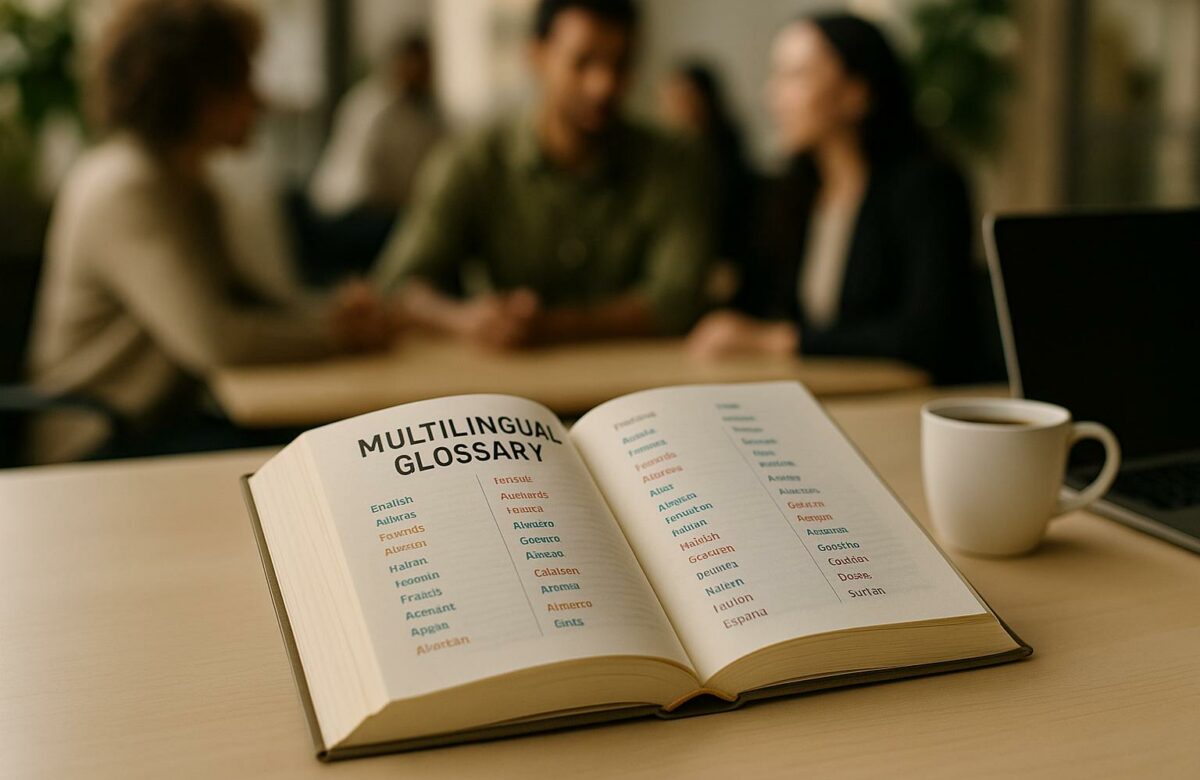How Glossaries Improve Multilingual Communication
Glossaries are essential for clear multilingual communication across languages. They ensure consistent terminology, reduce misunderstandings, and improve translation accuracy in professional settings. Here is why they matter:
- Consistency: Glossaries standardize terms, especially in technical fields like healthcare, legal, and finance, minimizing errors.
- Clarity: They provide precise, context-specific definitions, making complex language easier to understand.
- Support for Non-Native Speakers: Glossaries help non-native speakers navigate technical terms with clear explanations.
- Efficiency: Paired with AI tools, glossaries speed up translation processes and reduce costs by over 60%.
From healthcare to legal sectors, glossaries bridge language gaps by ensuring clear, accurate, and culturally relevant communication. Want to improve multilingual workflows? Start with a glossary.
Multilingual Communication: Main Benefits of Glossaries
Consistent Terms
Glossaries act as a reliable guide for maintaining consistent terminology, minimizing communication errors. By providing a single reference point, they ensure uniformity in technical translations, especially when paired with digital tools. For example, BeLikeNative incorporates multilingual glossaries to safeguard precise, industry-specific terminology across different languages.
Clear Communication
In multilingual environments, glossaries offer precise definitions that enhance understanding and professional application. This is especially critical in technical fields like healthcare, where standardized terms can reduce diagnostic mistakes, improve patient understanding, and simplify documentation. Essentially, glossaries serve as the backbone of clear and effective communication, particularly for professionals working in a second language.
Support for Non-Native Speakers
For non-native speakers, glossaries are an invaluable resource. They provide clear definitions, examples, and contextual explanations that help users navigate complex technical or professional language. This structured approach addresses common hurdles, such as:
- Grammatical errors caused by relying on native language structures
- Limited fluency due to insufficient language practice
- Memorizing vocabulary without understanding its context
- Awkward phrasing from direct translations
Multilingual Communication: Industry Uses of Glossaries
Medical Communication
In healthcare, precise translation of medical terms is essential for patient safety and effective care. Anne Backman, CMedO at Care to Translate, highlights this importance:
“A wound and an ulcer are the same word in Swedish, but in English, they have different meanings. Without careful translation, this can cause errors in patient care.”
Medical glossaries must also account for linguistic and cultural nuances in healthcare communication. Tove Karlsson from Doctrin shares an example:
“We had a translation for ‘Did you pass wind in the past 24 hours?’ but that was too polite. Patients did not grasp its meaning. We had to adjust to a more commonly understood phrase.”
These glossaries are not only vital for healthcare but also play a key role in technical fields by ensuring clarity and consistency.
Technical Documentation
Glossaries are a cornerstone of technical documentation, helping to manage complex information while supporting both internal teams and external audiences. They standardize terminology, improve readability, and simplify onboarding processes.
Elmira, a Technical Writer, emphasizes their value:
“A glossary will save you a lot of time, as you won’t have to guess meanings from context. Moreover, it will help you avoid mistakes.”
However, building and maintaining effective technical glossaries comes with challenges. Here are some common obstacles and their solutions:
| Challenge | Solution |
|---|---|
| Understanding data ownership | Clearly define roles and responsibilities for managing glossary content |
| Creating robust definitions | Develop strategic definitions based on actual data needs |
| Inconsistent participation | Gain executive support to ensure regular updates and engagement |
| Cloud migration complexity | Use centralized data governance policies to streamline the process |
Legal and Finance
In the legal and financial sectors, glossaries take on an even more critical role due to the need for regulatory precision. These specialized glossaries:
- Ensure consistency in terminology across translations
- Speed up translation processes with pre-defined references
- Guarantee accuracy in jurisdiction-specific language
The adoption of AI-powered translation tools, paired with these glossaries, has significantly boosted efficiency, cutting translation times and costs by over 60%.
To ensure both technical accuracy and cultural appropriateness, legal and financial glossaries should always be validated by native industry experts. This approach strengthens the reliability of professional communications while meeting industry-specific demands.
Step-by-Step Guide to Creating a Multilingual Communication Glossary!
sbb-itb-32359dc
Digital Tools for Glossaries & Multilingual Communication
Improving multilingual communication today goes beyond just standardizing terms – it requires the smart use of digital tools that make the process faster and more efficient.
Multilingual Communication: AI in Glossary Creation
AI is changing how glossaries are managed, making the process more streamlined and precise. Here’s how AI plays a role:
- Extracting key terms from unstructured text
- Compiling multilingual term lists with ease
- Ensuring consistency across translations
- Integrating with machine translation systems for better accuracy
According to Gartner, organizations are projected to spend a staggering $3 trillion on AI technologies between 2023 and 2027. Of that, 36% will go toward generative AI solutions. These advancements in AI are paving the way for more specialized tools that make glossary management even more effective.
Multilingual Communication: BeLikeNative Features

Modern glossary tools are designed to meet the demands of global communication. One standout example is BeLikeNative, which supports over 80 languages. It uses clipboard integration to refine terminology and improve translations seamlessly.
Spence Green, CEO of LILT, highlights the importance of such tools:
“Enterprise organizations are routinely forced to trade off between speed and local relevance in their global content creation strategy. LILT Create offers our customers an additional tool to optimize global content quickly.”
As technology progresses, even more groundbreaking tools are emerging to reshape how glossaries are managed.
Multilingual Communication: New Glossary Technologies
By 2025, Gartner predicts that 75% of application providers will redesign their product offerings to support API usage and composable applications. These trends are driving exciting developments in glossary technology:
| Technology | Immediate Benefit | Future Potential |
|---|---|---|
| Conversational AI | Supporting 70% of digital communications by 2025 | Smarter terminology learning and application |
| Virtual Reality | Becoming more realistic and accessible | Immersive training and collaboration opportunities |
| Blockchain | Ensuring secure, transparent term management | Verified and secure terminology usage |
| API Integration | Enabling seamless connectivity between systems | Unified terminology ecosystems |
The impact of these technologies is already being felt. For example, marketers using LILT Create with Contentful Connector have reported 90% faster content creation times. These innovations are setting the stage for a future where managing multilingual glossaries is faster, more accurate, and seamlessly integrated into global workflows.
Conclusion
Key Points Summary
Research highlights that well-thought-out glossary strategies play a crucial role in improving global communication. For instance, the Department of Justice’s August 2024 review of language access plans found that adopting standardized terminology and clear communication protocols significantly enhanced service delivery across federal agencies. This aligns with the article’s core message: bridging language barriers requires precise and consistent terminology.
“Language matters. Language is the thread that holds together our shared human experience. If your work is meant to impact people’s lives, you must commit to becoming more conscious of the importance of language.” – Sharda Sekaran
This quote emphasizes why glossaries are indispensable for ensuring clarity and consistency across multiple languages. With these benefits in mind, organizations can follow a clear roadmap to implement an effective glossary strategy.
Next Steps
To translate these insights into action, organizations can adopt a structured approach to strengthen their multilingual communication efforts:
| Implementation Phase | Actions | Expected Outcomes |
|---|---|---|
| Assessment | Gather language data and identify communication gaps | Gain a clear understanding of audience needs and priorities |
| Development | Create style guides and establish standardized terminology | Ensure a consistent brand voice across all languages |
| Integration | Deploy digital tools like BeLikeNative | Achieve a more efficient workflow and better communication outcomes |
| Optimization | Monitor usage and collect feedback | Continuously enhance the quality of communication |
“Without translation, we would be living in provinces bordering on silence”
As Steiner’s words remind us, multilingual communication is about more than just translating words – it’s about connecting cultures and fostering understanding. By strategically implementing glossaries and leveraging supportive technologies, organizations can elevate their global communication efforts while maintaining both consistency and cultural sensitivity.
FAQs
How do glossaries improve communication in specialized fields like healthcare and finance?
Glossaries play a key role in improving communication within specialized fields by standardizing terminology. They ensure that professionals are speaking the same language, which helps eliminate confusion and makes complex or technical information easier to understand.
Take industries like healthcare and finance, where accuracy is non-negotiable. Glossaries help avoid costly errors and misinterpretations by providing clear, consistent definitions. Whether it’s drafting medical reports, preparing financial documents, or collaborating across regions, these tools ensure everyone is aligned and working with the same understanding.
How does AI help create and manage glossaries for better multilingual communication?
AI makes creating and managing glossaries easier by automating the identification and organization of important terms. This helps maintain uniform and precise translations across various languages – an essential factor in professional multilingual environments.
By processing large amounts of multilingual data, AI can build detailed glossaries, keep them current, and ensure terms are aligned across languages. The result? Faster communication, fewer mistakes, and more streamlined translation processes.
What challenges arise when creating and managing glossaries, and how can they be addressed?
Creating and managing glossaries comes with its fair share of hurdles. One of the biggest challenges is maintaining accuracy and consistency across terms, especially when various teams have differing interpretations. On top of that, it can be a time-consuming task, requiring a lot of effort to gather, organize, and routinely update the terms.
To tackle these issues, consider starting with a small, focused glossary. This approach helps keep the scope manageable. Make sure your glossary is easy to access by integrating it into the tools your team already uses daily. Also, set up clear processes for regular updates and validation to ensure the terms stay accurate and relevant. By following these steps, your glossary can become a reliable tool for streamlining multilingual communication.


